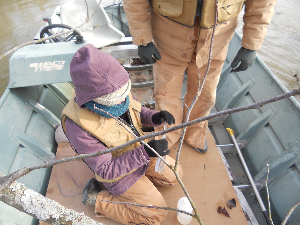Potential for Severe Buffalo Gnat Outbreak Along Sulphur River-Texarkana Area
TEXARKANA, Ark. –
Every winter Doug Petty, former Miller County Ag Agent, and I scout the Sulfur River multiple times to obtain counts on the amount of buffalo gnat larvae that we see and the potential for an outbreak.
In the past few weeks Doug and I have seen more Buffalo Gnat larvae than we have seen in 5 years of scouting. We took our findings to the local Buffalo Gnat Committee here in Texarkana. The Committee agreed we were at treatment levels and treating the river with a natural insecticide called Bacillus thuringiensus var israelensis (Bti) was deemed necessary. Bti is typically allowed in organic farming as an insecticide because Bti is a natural, non-pathogenic bacterium that is found naturally in the soil. Bti has also been found to be safe to all higher animals tested and is non-toxic to humans.
Unfortunately, due to excessive flooding and waters backed up in Bowie County, the U.S. Corp of Engineers were unable to lower the river. Without the river being lowered, we cannot treat.
Concerns:
Last year, an outbreak of southern buffalo gnats in late March and early April caused the deaths of nearly 100 domesticated animals and at least 280 deer in Arkansas County, University of Arkansas System Division of Agriculture researchers said this week. Arkansas County residents reported the deaths of three bulls, 30 cows, 30 calves, 27 horses, several mules and a dog. In Southwest Arkansas, outbreaks tend to happen in late January through early March.
Swarms of southern buffalo gnats tend to kill animals in one of several different ways. There can be death due to blood loss — exsanguination. There can be death from a large number of flies blocking the air passageway — essentially, suffocation. But if you look at a lot of the literature, it suggests that most of the deaths will be due to toxemia. Basically, the animal reacting to the saliva, the anticoagulants in the salivary glands of the gnats.
When you have massive attacks from the southern buffalo gnat, the deaths are likely caused by acute toxemia or anaphylactic shock. It’s not a pathogen — it’s just the toxins in the salivary glands.
Symptoms:
Humans as well as domestic animals may be viciously attacked. The eyes, ears, nostrils, wrists, and all exposed parts of the body of man are subject to attack. The extreme pain, itching, and the resultant local swellings, together with occasional severe complications, indicate the presence of an active allergin. In some individuals, the face, arms, and other exposed parts may be greatly swollen as a result of the bites; in others, effects other than blood loss may scarcely be noticeable. Livestock and poultry are sometimes killed by large numbers of black flies.
What are Buffalo Gnats?
Black flies are tiny, blood-sucking flies in the insect family Simuliidae and are often called buffalo gnats or turkey gnats. Contrary to their name, black flies may be gray, tan, or even greenish. They breed in fast moving water of streams and rivers. They are tremendous pests of humans, domestic animals, and wildlife every spring.
Control Options:
For Livestock:
Smokers – Burning hay and logs should create enough smoke to keep the gnats from livestock
Move – Moving livestock more than 5 miles from the Sulfur River will reduce numbers
Darkness/Shelter – Animals may be stabled during the day
Repellents – Fly repellents including permethrin applied to the chest, belly, and ears are somewhat effective
For Pets:
Bring Inside - Bring pets indoors during the day
Screen- Cover pen with screen or mosquito netting
Repellents – Fly repellents applied to pets are somewhat effective. Vanilla extract or Skin-So-Soft.
Fans – Strong air currents are not favored by gnats.
Sprays – Treat under shrubs, trees, and underbrush in evenings while gnats are at rest.
For People:
Indoors – Stay indoors during the daylight hours.
Fans – Fans blowing around doorways will reduce numbers entering a house.
Repellents – Clothing treated with fly repellents such as Permanone. Avon Skin-So-Soft Bug Guard
wipe on (picaridin) and others can be used on the skin.
Clothing – Do not wear light blue. Wear layers of light clothing closed at collar and wrists.
Head protection - Wear head and/or shoulder nets.
Wear gloves and cap.
Please contact your local county extension office for current information.
By Jennifer Caraway
County Extension Agent - Agriculture
The Cooperative Extension Service
U of A System Division of Agriculture
Media Contact: Jennifer Caraway
County Extension Agent - Agriculture
U of A Division of Agriculture
Cooperative Extension Service
400 Laurel Street, Suite 215 Texarkana AR 71854
(870) 779-3609
jcaraway@uada.edu
Related Links
The Arkansas Cooperative Extension Service is an equal opportunity institution.
If you require a reasonable accommodation to participate or need materials in another
format, please contact your County Extension office (or other appropriate office)
as soon as possible. Dial 711 for Arkansas Relay.
Pursuant to 7 CFR § 15.3, the University of Arkansas System Division of Agriculture
offers all its Extension and Research programs and services (including employment)
without regard to race, color, sex, national origin, religion, age, disability, marital
or veteran status, genetic information, sexual preference, pregnancy or any other
legally protected status, and is an equal opportunity institution.
